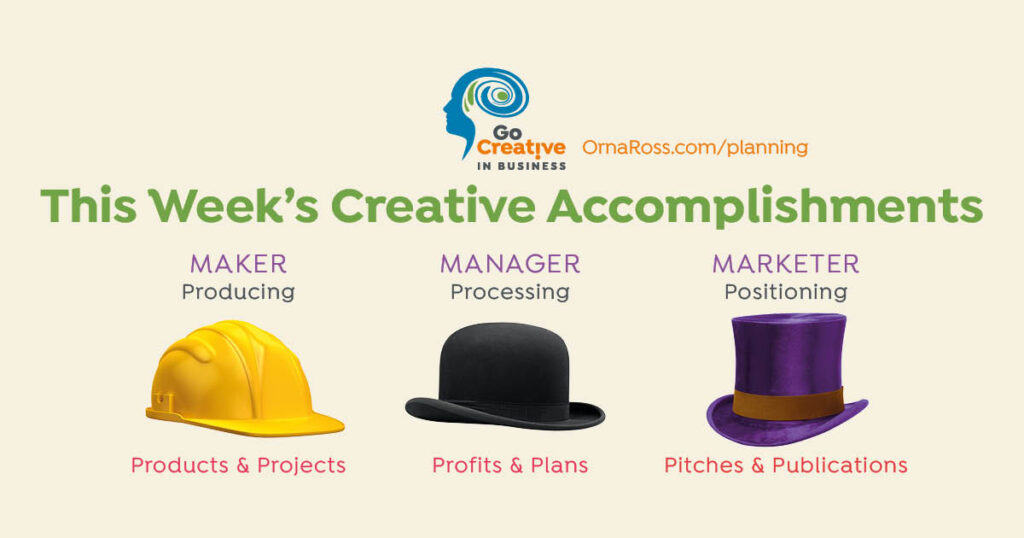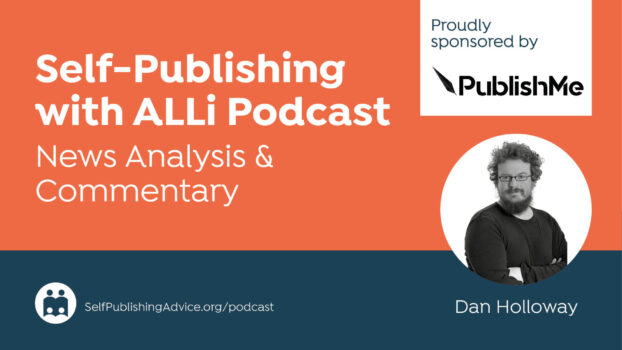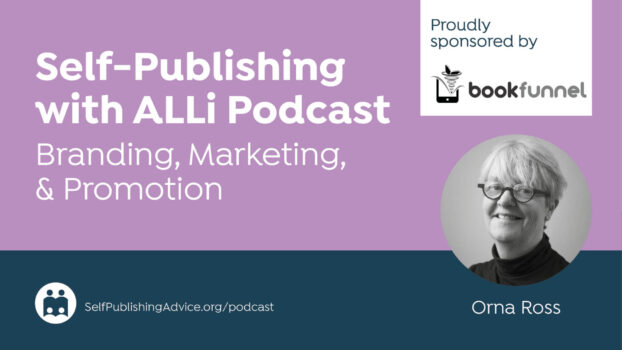Are you ready for 2023? Alliance of Independent Authors founder and director Orna Ross runs a Creative Planning for Profit program for indie authors and we are running a blog series introduction to the method. Today in Part 4: Integrating Your Writing and Publishing, she introduces the three hats an independent author must wear to write and publish for profit.
In Part 1, you explored the unique value you bring to your readers, in Part 2 the creative process as applied to business, and in part 3, the importance of balancing creative rest and play with creative work. In this fourth and final post in the series, we look at how to integrate your writing and publishing activities.
The indie author's job has three parts: to produce, to promote, to process. To produce words and books (and maybe other products and services) and the smaller publications (blog posts, articles, stories, newsletters, social media updates etc) that market them. To promote the books and products and services and build a readership. All of which depends on the ability to process strategies and turn them into profits.
Together, these three–production, promotion and processing–create an integrated publishing business. Not understanding how these different parts of the publishing business work, and work together, is a common reason indie authors get stuck.
When we separate out these three roles and function, rather than just seeing ourselves as writers who publish, or primarily as writers, we begin to more clearly perceive what the job of being an indie author actually asks of us, day by day, week by week, month by month.
Integrating Your Writing and Publishing: Three Hats
At a practical level, integrating your writing and publishing activities means donning and doffing of three different hats, best described as Maker Hat, Manager Hat and Marketeer Hat.
When we map intentions wearing our different hats, seeing how different their work is, it all begins to hang together and make more sense.
In order to understand and integrate them, let’s first separate them out.
• You put on your Maker Hat for the work you do in your business, making the products you sell and the materials that help you sell them. Your Maker's key task is production—writing words and producing books, of course, but also producing other products needed to promote your books, perhaps in text form, or perhaps as audio or video or merchandise. These book-based products feed your creative mission and passion while also being used to promote your work and boost your profits.
• You put on your Manager Hat for the work you do on your business: as you turn the resources available to you–your time and money, your tools and team, your talent and capacity– into writing and publishing processes that work for you, creatively and commerciallly. Your Manager's key task, therefore, is processing—actioning, organizing, improving, maximising.
• You put on your Marketeer Hat for the work you do to grow your business, as you pitch, publicize, and partner with others to reach more readers and sell more books. Your key Marketeer task is promotion—attracting readers with compelling content and communications that bring them to buy.
Let’s look more closely at how your Maker, Manager and Marketeer think—what they believe, how they spend time, what they need to watch out for, and what they most want.
Each hat has its strengths and weaknesses and each needs attention from you throughout the month, if you are to succeed as an indie author.
Integrating Your Writing and Publishing: Maker (Books, Other Products and Publications)
Your Maker works in the business. Wearing this hat, you are a creative artist overseeing writing craft and publishing craft.
As Maker, you believe that finding and keeping readers happy is a matter of creating great books and products.
For Maker, the job is to write the best possible words and produce the best possible books and other products and services. Maker has three categories of work to produce.
- Writing: The Maker produces words. Writing is always the top priority
- Books: The Maker produce books and perhaps other products for sale, from those words.
- Marketing Materials: The Maker produces marketing content like blurbs, press releases, explainers, trailers, adverts, blog posts, newsletters, articles, etc. We include this under Maker hat because it takes writing time to compose these important documents. You will take them out to the world wearing your Marketeer hat but first Maker must make them.
Maker also works with editors and designers and perhaps other writers on publishing craft decisions around edits, covers, illustrations, and any other features of the books and the writing.
• Fears: Maker fears that they are not a good enough writer or publisher to succeed.
• Focus: Maker is focused inwards.
• Money: Maker prefers not to think about money, except for believing that someday they’ll “make it.”
• Quote: Maker’s motto is: “If you build it, they will come.”
• Success: Maker defines success in terms of productivity.
• Time: Maker’s time frame is now. “What I produce today could change everything tomorrow.” Maker pushes the pace, feeling there’s never enough time to make all they want to make.
• Wants: Maker craves the solitude and space to create.
• Blocker: The “I’m creative, not commercial” duality; blaming others, or conditions, for lack of creativity or production; thinking books sell themselves if they’re “good enough”; forgetting about money until the need becomes critical; neglecting or even disdaining the need for management, money, or marketing.
For Maker, the creative question is: how do I find enough time and creative space to make my stuff?
Integrating Your Writing and Publishing: Marketeer (Promotion and Sales)
The Marketeer works to grow the business. Wearing this hat you are a creative communicator overseeing pitches, publicity and partnerships.
As Marketeer, you believe finding and keeping happy customers is about making sales and getting read. For Marketeer, the job is to turn ideas and products into impact and influence.
• Fears: Marketeer fears all of Maker’s craft and productivity will go unseen and unrewarded.
• Focus: Marketeer is focused outwards, on partnerships and publicity that enable the books to be more findable and widely disseminated.
• Money: For Marketeer, money is a measure of whether the books are reaching enough readers.
• Quote: Marketeer’s motto is: “The reader is King.” CJ Lyons.
• Time: Marketeer is future based, starting with a picture of a desirable future, and then working back to the present to make the changes that will measure up to that vision.
• Success: For Marketeer, success is fame and fortune.
• Wants: Marketeer craves income, influence and impact.
• Blocker: too much focus on the market and other people's opinions. Shiny object syndrome. Brash claims and crass schemes. Forgetting that business serves life, not vice versa.
For Marketeer, the creative question is: how do I reach more readers and sell more books?
Integrating Your Writing and Publishing: Manager (Processes and Profits)
Your Inner Manager works on your publishing business. Wearing this hat, you are a creative director overseeing time, money and energy. As Manager, you believe that finding and keeping readers happy is a matter of getting pricing, features, availability and support right, and having good problem-solving processes for when things go wrong.
For Manager, the job is to integrate money and mission, passion and profits into a sustainable, scalable business. The features of the business itself, not just the products it makes, are what’s important.
• Fears: Manager fears Maker and Marketer will run the business into trouble if not attentively directed.
• Focus: Manager takes a holistic view. They see the business as a system that should deliver commercial profit and creative pleasure to all involved.
• Money: Manager thinks of money as foundational, funding and protecting the processes that allow Maker’s production to happen, and Marketeer’s growth to happen. To Manager, how money is spent, invested or withheld is the truest statement of the business’s values.
• Quote: Manager’s motto is: “You don’t build a business. You build people and processes, and they build the business.” Zig Ziglar.
• Success: For Manager, success is running an integrated business that supports a secure and happy lifestyle.
• Time: Manager thinks about the past, and demonstrated capacity. What’s been achieved so far is the best indicator of what’s to come. Manager’s pace is measured.
• Wants: Manager craves order, safety, and security.
• Beware: joylessness, anxiety, rigidity. Over reliance on data. Underestimating the power of creative spontaneity. Being risk averse.
For Manager, the creative question is: how do I set up and maintain processes that allow this business to succeed?
Integrating Your Writing and Publishing: Bringing the Three Together
These are the three hats you must wear as an indie author.
- In your marketing, you focus on real connections with other human beings—your readers, the authors in your niche whose work you most admire, literary influencers who can take your books to more readers.
- In your managing, you are kind and fair to your team members, the services you use, and considerate and true to your readers.
- In your making, you communicate from your deepest experience, using your own voice, telling your own truths, being as unique and as creative as you dare to be.
 Find out more about this and how it all hangs together in my book, Creative Self-Publishing.
Find out more about this and how it all hangs together in my book, Creative Self-Publishing.
If you would like more support, including regular workshops and a weekly accountability group, find out more about my Creative Planning for Profit Program here.






Hi Orna,
Thanks for putting these together, they’ve been ridiculously helpful for me as a beginner just wrapping my head around the business side of publishing. I read them, bookmarked them, and saved them for when I had had a chance to do a bit more research on just how businesses should be set-up in Australia am now ready to dive back into the planning process, however:
I can’t find part 3 anywhere? Any idea what might have happened to it? It’s not in the blog list and I can’t find it via google either. Would love to find it again so I can round this step off.
Thanks again,
Tom.